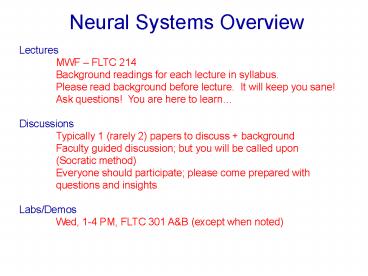Neural Systems Overview - PowerPoint PPT Presentation
1 / 13
Title:
Neural Systems Overview
Description:
Neural Systems Overview. Lectures. MWF FLTC 214. Background ... Science', 4th edition for lectures and Woolsey et al, 3rd edition for labs is a good idea ... – PowerPoint PPT presentation
Number of Views:68
Avg rating:3.0/5.0
Title: Neural Systems Overview
1
Neural Systems Overview
Lectures MWF FLTC 214 Background readings for
each lecture in syllabus. Please read
background before lecture. It will keep you
sane! Ask questions! You are here to
learn Discussions Typically 1 (rarely 2)
papers to discuss background Faculty guided
discussion but you will be called upon
(Socratic method) Everyone should participate
please come prepared with questions and
insights Labs/Demos Wed, 1-4 PM, FLTC 301 AB
(except when noted)
2
Grading
Two take-home exams (midterm and final) 80 of
grade from take-home exams Exam schedules (
reviews) in syllabus Let me know about conflicts
ASAP Two lab exams 20 of grade from lab
exams In class short answers to slide-related
questions Labs are condensed study off-site
and often Seek out faculty and TA (Joe
Castellano) for help No required text but
having a copy of Kandel, Schwartz, and Jessel,
Principles of Neural Science, 4th edition for
lectures and Woolsey et al, 3rd edition for labs
is a good idea
3
You should know
This is a Neuroscience course Knowledge of
elements and structures (new nomenclature) Low-le
vel physiology as well as high-level
cognition Some psychophysics, behavior Some
math, quantitative approaches You all have
different backgrounds Some things will be
easier, some harder Learn from each other Be
open minded, ask questions
4
What is Systems Neuroscience?
Neural Systems focus on how complex functions
that arise from communication among
the cellular elements of the
nervous system and from interactions with other
physiological systems and the
environment. Four general neural system themes
will be emphasized Sensory systems Motor
systems Arousal attention Cognitive
processing Is this inclusive? No, but an
eclectic overview for you to gain insight into
global issues of brain function, perception,
decision, behavior, and awareness
5
Levels of Analysis
Systems neuroscience
Cellular neuroscience
After Churchland Sejnowski 1992
6
Historical Approaches
Anatomy Understand the nervous system
structure that gives rise to function Psychology
Understand behavior, learning, bias, and insight
arising from neural function Neurobiology Under
stand how neural cells function, respond to
stimuli, are organized, and how they process
information Engineering/Computational Understand
complex processing and model neural circuits
7
Some Elements of the Modern Systems Approach
- Focus on how neural circuits process information.
- What is coded and how?
- Understand how neural representations are
distinct - and how they are tailored for different functions
- Relate neural activity to behavior, e.g. learning
- Models must respect biological implementation
8
The Basic Brainstem Circuit for the VOR when the
head turns to the left
The short latency simple VOR path consists of 3
neurons 1) afferent fiber 2) central VNC
neuron 3) eye muscle motor neuron With a left
head rotation 1) Left afferents excited, right
inhibited 2) VNC cells on left excited 3) VNC
projects excitatory input to contralateral
(right) abducens neurons 4) Abducens motor
neurons excite right lateral rectus 5) Abducens
interneurons project back across to excite left
oculomotor neurons and left medial rectus 6)
Opposite action inhibitory path from right canal
and circuit
9
Course Goals What should a systems
neuroscientist know?
- Factual Knowledge
- The hardware neuroanatomy and connectivity
- What the hardware elements can do
neurophysiology - How specific systems are organized and how they
work - What tools are available methods
- Conceptual Knowledge
- Neural Coding
- Neural Representations
- Population activity
- Maps
- Behavior
10
Methods and Tools
- Anatomical
- Neuron morphology
- Pathways
- Stuctures and nuclei
- MRI
- Physiological (Invasive)
- Single-unit recording
- Multiple-unit population recordings
- Optical imaging
- Electrical microstimulation
- Reversible inactivation
- Viral expression and imaging
11
Methods and Tools (cont.)
- Physiological (Non-Invasive)
- EEG Brain Map
- fMRI
- PET
- Behavioral
- Psychophysics
- Motor control
- Learning
- Stimulus/response
- Modeling and Engineering Approaches
- Linear (and non-linear) systems analysis
- Control systems analysis
- Self-organizing networks
12
Methods Spatial and Temporal Resolution
PET
fMRI
lesions
microlesions
light microscopy
13
Comparative approach































